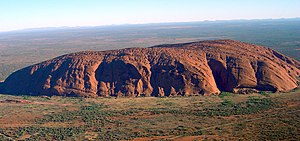After the High Court’s Mabo decision, Australian governments have passed a series of Native Title Acts, firstly to set up a system to determine Native Title and later to restrict Native Title claims by Indigenous people.

Uluru, then-known as Ayers Rock by non-indigenous Australians, provided the band’s name.
The Native Title Act (Cth) was introduced by the Keating Labor government in 1993 and came into operation on 1st January 1994. The Act recognises the common law principle of native title, as established by the High Court Mabo (2) decision. It gave validity to past grants of interests in land or waters made invalid because of native title. The Act also sets out the structures by which native title claims can be determined, and it provides a framework for future dealings affecting native title. The Act also established the Native Title Tribunal, whose functions include the determination of claims asserting the existence of native title.
The four major aims of the Native Title Act (1993) were:
- to provide for the recognition and protection of native title; and
- to establish ways in which future dealings affecting native title may proceed and to set standards for those dealings; and
- to establish a mechanism for determining claims to native title; and
- to provide for, or permit, the validation of past acts invalidated because of the existence of native title. (Commonwealth of Australia, Native Title Act 1993, Section 3)
Amending the Native Title Act
In March 1996, the Howard Coalition government came to power and set in train its policy to amend the Native Title Act to make it, it said, ‘more workable’. The proposed amendments presented in the government’s ’10-point plan’ raised heated debate, particularly among the Indigenous community. The High Court of Australia’s ruling in the Wik case in December of 1996 escalated the debate. The High Court determined that native title can and does co-exist with pastoral leases to the extent that pastoral lease rights prevail over those of the native title holders.
In 1997, the government presented its Native Title Amendment Bill (1997). The amended Act severely restricts Indigenous rights in favour of those of non-Indigenous pastoralists and other economic interests.
Key Idea
After the High Court’s Mabo decision, Australian governments have passed a series of Native Title Acts, firstly to set up a system to determine Native Title and later to restrict Native Title claims by Indigenous people.
The Native Title Act (Cth) was introduced by the Keating Labor government in 1993 and came into operation on 1st January 1994. The Act recognises the common law principle of native title, as established by the High Court Mabo (2) decision. It gave validity to past grants of interests in land or waters made invalid because of native title. The Act also sets out the structures by which native title claims can be determined, and it provides a framework for future dealings affecting native title. The Act also established the Native Title Tribunal, whose functions include the determination of claims asserting the existence of native title.
The four major aims of the Native Title Act (1993) were:
Amending the Native Title Act
In March 1996, the Howard Coalition government came to power and set in train its policy to amend the Native Title Act to make it, it said, ‘more workable’. The proposed amendments presented in the government’s ’10-point plan’ raised heated debate, particularly among the Indigenous community. The High Court of Australia’s ruling in the Wik case in December of 1996 escalated the debate. The High Court determined that native title can and does co-exist with pastoral leases to the extent that pastoral lease rights prevail over those of the native title holders.
In 1997, the government presented its Native Title Amendment Bill (1997). The amended Act severely restricts Indigenous rights in favour of those of non-Indigenous pastoralists and other economic interests.
Content is available under the
Creative Commons Attribution Share Alike License.
Privacy Policy | Authors